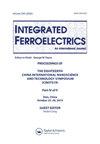烧结温度对固态燃烧法制备0.85[0.94Bi 0.5 Na 0.5 tio3 -0.06 batio3]-0.15[Na 0.73 Bi 0.09 nbo3]陶瓷相演化及电性能的影响
IF 0.7
4区 工程技术
Q4 ENGINEERING, ELECTRICAL & ELECTRONIC
引用次数: 0
摘要
摘要本文描述了采用固态燃烧技术制备0.85[0.94Bi0.5Na0.5TiO3-0.06BaTiO3]-0.15[Na0.73Bi0.09NbO3] (BNT-BT-NBN)陶瓷。测试了材料的相演化、微观结构、介电性能、铁电性能和储能性能。BNT-BT-NBN粉末和陶瓷分别在650-900℃和1100-1175℃之间煅烧和烧结2 h, x射线衍射结果表明,样品均为典型的钙钛矿结构。陶瓷的Rietveld细化分析表明,在1100 ~ 1150℃之间烧结的样品中存在R + T相共存,而在1175℃烧结的陶瓷中存在R + T+C相。随着烧结温度的升高,样品的平均晶粒尺寸由0.52 μm增大到1.39 μm。当烧结温度从1100℃升高到1150℃时,陶瓷的密度由5.12 g/cm3增加到5.45 g/cm3,然后下降。当烧结温度从1100℃升高到1150℃时,Ts处的介电常数(εs)和Tm处的介电常数(εm)分别从1727 ~ 1945和1564 ~ 1750增加,然后εs和εm下降。所有BNT-BT-NBN陶瓷具有良好的介电温度稳定性,当温度范围从室温到~ 300°C时,仅变化±10%。结果表明,在1150℃下烧结2h的BNT-BT-NBN陶瓷具有最佳的储能性能(Wrec = 0.62 J/cm3, η = 83.2%),可作为高密度储能电容器的无铅材料。关键词:bnt - bt - nbnn相演化rietveld精化电学性能燃烧方法致谢作者感谢河南大学理学院物理系提供的支持设施。同时感谢Kyle V. Lopin博士助理教授对本文的编辑工作。本研究由国家科学研究与创新基金(NSRF)通过南京大学资助(R2565B059)。本文章由计算机程序翻译,如有差异,请以英文原文为准。
Effect of the Firing Temperatures on the Phase Evolution and Electrical Properties of 0.85[0.94Bi 0.5 Na 0.5 TiO 3 -0.06BaTiO 3 ]-0.15[Na 0.73 Bi 0.09 NbO 3 ] Ceramics Synthesized via the Solid-State Combustion Method
AbstractIn this research paper, we describe 0.85[0.94Bi0.5Na0.5TiO3-0.06BaTiO3]-0.15[Na0.73Bi0.09NbO3] (BNT-BT-NBN) ceramics fabricated by the solid-state combustion technique. The phase evolution, microstructure, dielectric, ferroelectric and energy storage properties were examined. The BNT-BT-NBN powders and ceramics were calcined and sintered between 650–900 °C and 1100–1175 °C, respectively, for 2 h. All samples showed a typical perovskite structure, as revealed by X-ray diffraction. The Rietveld refinement analysis of the ceramics suggested the samples sintered between 1100 and 1150 °C had coexisting R + T phases, while the R + T+C phases were observed in the ceramics sintered at 1175 °C. The average grain size of the samples increased from 0.52 to 1.39 μm with increased sintering temperature. The density of the ceramics increased from 5.12 to 5.45 g/cm3 when the sintering temperature increased from 1100 to 1150 °C, and then decreased. Increasing the sintering temperature from 1100 to 1150 °C caused the dielectric constant at Ts (εs) and the dielectric constant at Tm (εm) to increase from 1727 to 1945 and 1564 to 1750, respectively, and then εs and εm declined. All BNT-BT-NBN ceramics had good dielectric temperature stability with only a±10% change when the temperature ranged from room temperature to ∼300 °C. The optimum energy-storage properties (Wrec = 0.62 J/cm3 and η = 83.2%) were obtained from the BNT-BT-NBN ceramics sintered at 1150 °C for 2 h. This data indicates that BNT-BT-NBN ceramics can be useful as lead-free materials for high density energy-storage capacitors.Keywords: BNT-BT-NBNphase evolutionRietveld refinementelectrical propertiescombustion method AcknowledgmentsThe authors wish to thank the Department of Physics, Faculty of Science, Naresuan University for their supporting facilities. Thank are also given to Asst. Prof. Dr. Kyle V. Lopin for his help in editing the manuscript.Additional informationFundingThis work was financially supported by The National Science, Research and Innovation Fund (NSRF) through Naresuan University (R2565B059).
求助全文
通过发布文献求助,成功后即可免费获取论文全文。
去求助
来源期刊

Integrated Ferroelectrics
工程技术-工程:电子与电气
CiteScore
1.40
自引率
0.00%
发文量
179
审稿时长
3 months
期刊介绍:
Integrated Ferroelectrics provides an international, interdisciplinary forum for electronic engineers and physicists as well as process and systems engineers, ceramicists, and chemists who are involved in research, design, development, manufacturing and utilization of integrated ferroelectric devices. Such devices unite ferroelectric films and semiconductor integrated circuit chips. The result is a new family of electronic devices, which combine the unique nonvolatile memory, pyroelectric, piezoelectric, photorefractive, radiation-hard, acoustic and/or dielectric properties of ferroelectric materials with the dynamic memory, logic and/or amplification properties and miniaturization and low-cost advantages of semiconductor i.c. technology.
 求助内容:
求助内容: 应助结果提醒方式:
应助结果提醒方式:


